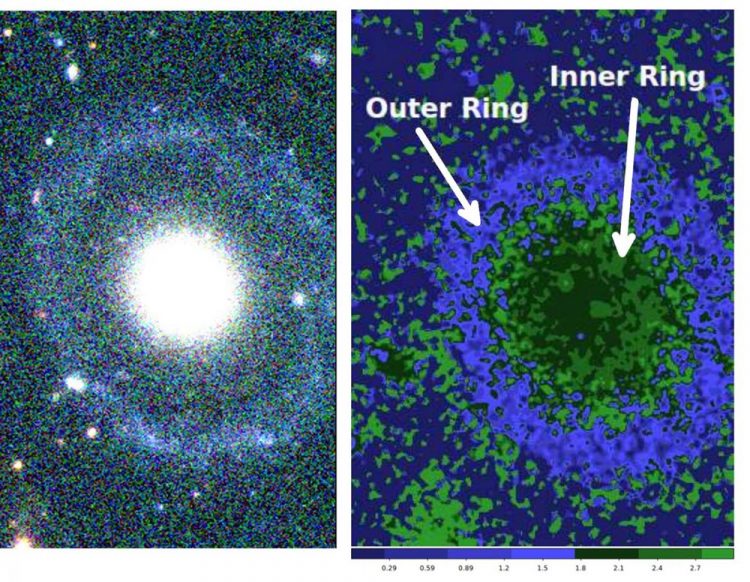Researchers get first look at new, extremely rare galaxy

The left panel shows a false-color image of PGC 1000714. The right panel shows a B-I color index map that reveals both the outer ring (blue) and diffuse inner ring (light green). Credit: Ryan Beauchemin
“Less than 0.1% of all observed galaxies are Hoag-type galaxies,” says Burcin Mutlu-Pakdil, lead author of a paper on this work and a graduate student at the Minnesota Institute for Astrophysics, University of Minnesota Twin Cities and University of Minnesota Duluth.
Hoag-type galaxies are round cores surrounded by a circular ring, with nothing visibly connecting them. The majority of observed galaxies are disc-shaped like our own Milky Way. Galaxies with unusual appearances give astronomers unique insights into how galaxies are formed and change.
The researchers collected multi-waveband images of the galaxy, which is only easily observable in the Southern Hemisphere, using a large diameter telescope in the Chilean mountains. These images were used to determine the ages of the two main features of the galaxy, the outer ring and the central body.
While the researchers found a blue and young (0.13 billion years) outer ring, surrounding a red and older (5.5 billion years) central core, they were surprised to uncover evidence for second inner ring around the central body. To document this second ring, researchers took their images and subtracted out a model of the core. This allowed them to observe and measure the obscured, second inner ring structure.
“We've observed galaxies with a blue ring around a central red body before, the most well-known of these is Hoag's object. However, the unique feature of this galaxy is what appears to be an older diffuse red inner ring,” says Patrick Treuthardt, co-author of the study and an astrophysicist at the North Carolina Museum of Natural Sciences.
Galaxy rings are regions where stars have formed from colliding gas. “The different colors of the inner and outer ring suggest that this galaxy has experienced two different formation periods,” Mutlu-Pakdil says. “From these initial single snapshots in time, it's impossible to know how the rings of this particular galaxy were formed.” The researchers say that by accumulating snapshot views of other galaxies like this one astronomers can begin to understand how unusual galaxies are formed and evolve.
While galaxy shapes can be the product of internal or external environmental interactions, the authors speculate that the outer ring may be the result of this galaxy incorporating portions of a once nearby gas-rich dwarf galaxy. They also say that inferring the history of the older inner ring would require the collection of higher-resolution infrared data.
“Whenever we find a unique or strange object to study, it challenges our current theories and assumptions about how the Universe works. It usually tells us that we still have a lot to learn,” says Treuthardt.
###
An uncorrected proof of the peer-reviewed paper, “A photometric study of the peculiar and potentially double ringed, nonbarred galaxy: PGC 1000714,” was published online in the Monthly Notices of the Royal Astronomical Society by Oxford University Press on Nov. 30, 2016 and will appear online at http://doi.
Note to Editors: The study abstract follows.
“A photometric study of the peculiar and potentially double ringed, nonbarred galaxy: PGC 1000714”
Authors: Burcin Mutlu Pakdil, University of Minnesota Duluth and University of Minnesota Twin Cities; Mithila Mangedarage, University of Minnesota Duluth; Marc S. Seigar, University of Minnesota Duluth; Patrick Treuthardt, North Carolina Museum of Natural Sciences
Published: Nov. 30, Monthly Notices of the Royal Astronomical Society
DOI: 10.1093/mnras/stw3107
Abstract: We present a photometric study of PGC 1000714, a galaxy resembling Hoag's Object with a complete detached outer ring, that has not yet been described in the literature. Since the Hoag-type galaxies are extremely rare and peculiar systems, it is necessary to increase the sample of known objects by performing the detailed studies on the possible candidates to derive conclusions about their nature, evolution, and systematic properties. We therefore performed surface photometry of the central body by using the archival near-UV, infrared data and the new optical data (BVRI). This current work has revealed for the first time an elliptical galaxy with two fairly round rings. The central body follows well a r1/4 light profile, with no sign of a bar or stellar disc. By reconstructing the observed spectral energy distribution (SED), we recover the stellar population properties of the central body and the outer ring. Our work suggests different formation histories for the galaxy components. Possible origins of the galaxy are discussed, and we conclude that a recent accretion event is the most plausible scenario that accounts for the observational characteristic of PGC 1000714.
Media Contact
All latest news from the category: Physics and Astronomy
This area deals with the fundamental laws and building blocks of nature and how they interact, the properties and the behavior of matter, and research into space and time and their structures.
innovations-report provides in-depth reports and articles on subjects such as astrophysics, laser technologies, nuclear, quantum, particle and solid-state physics, nanotechnologies, planetary research and findings (Mars, Venus) and developments related to the Hubble Telescope.
Newest articles

Properties of new materials for microchips
… can now be measured well. Reseachers of Delft University of Technology demonstrated measuring performance properties of ultrathin silicon membranes. Making ever smaller and more powerful chips requires new ultrathin…

Floating solar’s potential
… to support sustainable development by addressing climate, water, and energy goals holistically. A new study published this week in Nature Energy raises the potential for floating solar photovoltaics (FPV)…

Skyrmions move at record speeds
… a step towards the computing of the future. An international research team led by scientists from the CNRS1 has discovered that the magnetic nanobubbles2 known as skyrmions can be…





















